Australia's eSafety Commissioner Demands X Censor Murder Footage, Faces $825K Daily Fine Threat
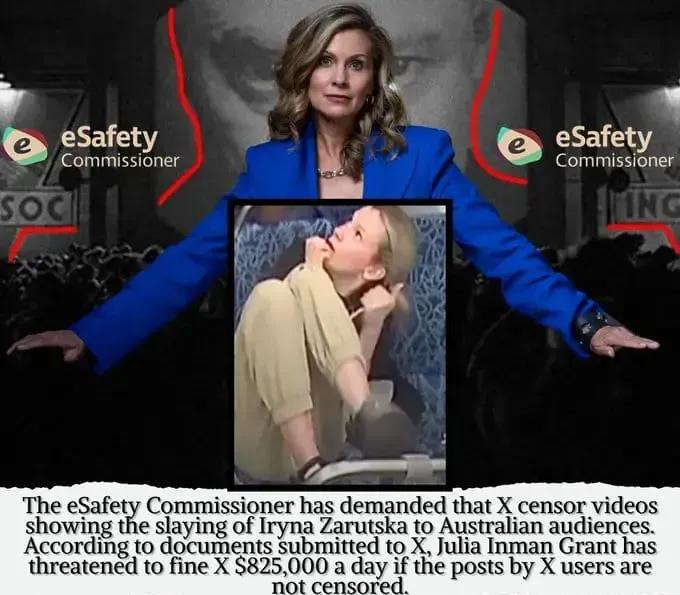
Free Speech Union challenges latest censorship attempt as constitutional battle escalates
Australia's eSafety Commissioner Julie Inman-Grant has issued a controversial removal notice to X (formerly Twitter), demanding the platform censor 23 posts containing CCTV footage of Iryna Zarutska's murder. The September 26, 2025 notice threatens fines of AU$825,000 per day if X fails to comply, sparking a fresh constitutional challenge from the Free Speech Union of Australia.
The Case: What Happened to Iryna Zarutska
The dispute centers on raw CCTV footage showing the final moments of Iryna Zarutska, who was killed by a convicted criminal while commuting to work on a train in Charlotte, North Carolina. The footage, released publicly by Charlotte Area Transit System, has circulated widely on social media platforms worldwide.
The 23 targeted posts include commentary from journalists and online commentators discussing the case, with many criticizing what they perceive as double standards in how Western media covers violent crimes depending on the victim's background and the perpetrator's identity.
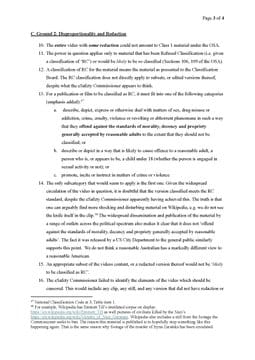
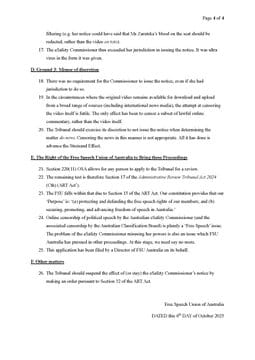
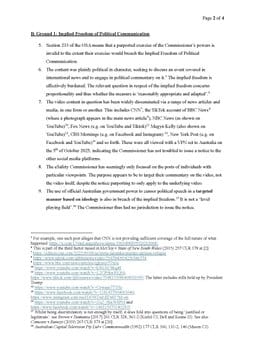
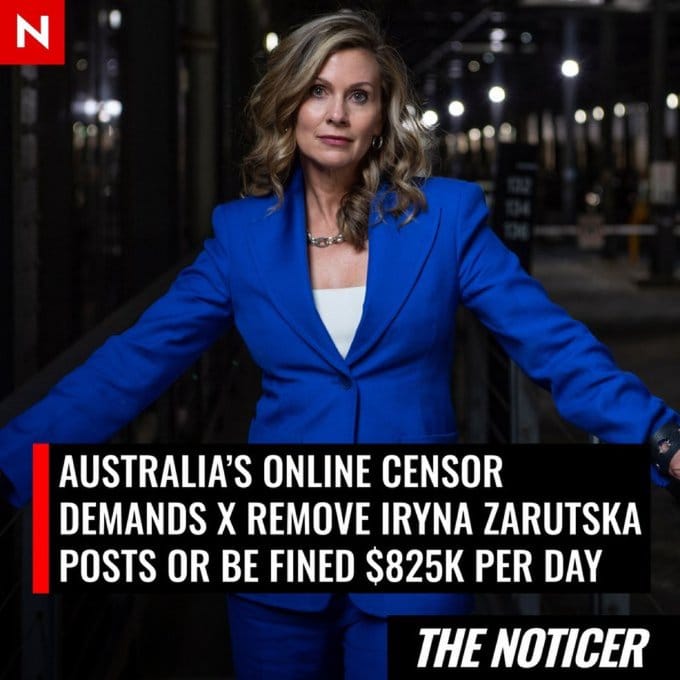
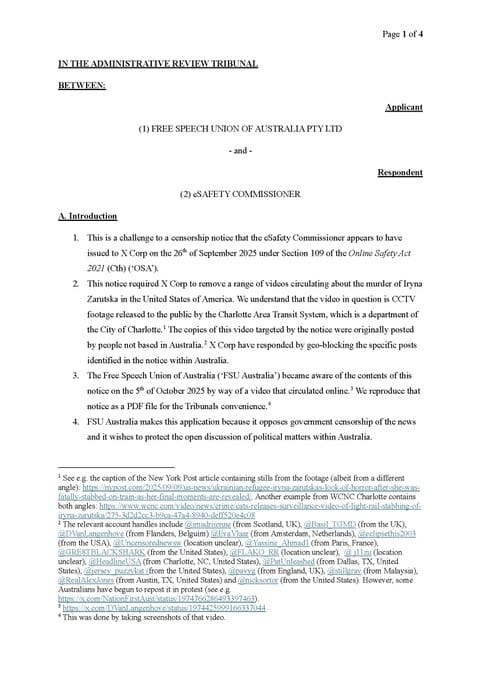
The Legal Challenge
The Free Speech Union of Australia (FSU Australia) has filed a challenge in the Administrative Review Tribunal, arguing that the removal notice constitutes government censorship of legitimate news discussion and violates constitutional protections for free speech.
According to the FSU's tribunal submissions, the eSafety Commissioner's approach contains several critical flaws:
Constitutional concerns: The FSU argues that while the Commissioner claims to be censoring the video itself, the practical effect is censoring the tweets and public discourse surrounding them. The submissions state this "breaches an important constitutional right in Australia" - specifically, the implied freedom of political communication recognized by Australian courts.
Scope overreach: The notice attempts to censor entire videos rather than specific harmful content, which the FSU characterizes as a misuse of the Commissioner's powers under the Online Safety Act 2021.
Selective enforcement: The challenge questions why Australians can view violence from war zones but are prevented from accessing footage central to public debate about criminal justice failures and media coverage standards.
Who is Julie Inman-Grant?
Julie Inman-Grant, Australia's eSafety Commissioner since 2017, has developed an international reputation for aggressive internet regulation. A former Twitter employee and regular World Economic Forum participant, she has previously clashed with X over content moderation.
The Commissioner has already lost multiple court battles in her efforts to expand the reach of Australian content regulation:
- In 2024, she attempted to force X to globally remove content related to a stabbing incident in Sydney, leading to a high-profile legal defeat
- Her office has been criticized for costing Australian taxpayers significant legal expenses in unsuccessful censorship attempts
- Critics have dubbed her "E-Karen" for what they view as overreach in her regulatory authority
The Legal Framework
The removal notice was issued under Section 109 of the Online Safety Act 2021, which gives the Commissioner power to require removal of "class 1 material" - content depicting extreme violence, among other categories.
However, the FSU's challenge argues that:
- The footage constitutes newsworthy content already in the public domain through official government channels
- The posts include substantial commentary and analysis, not merely raw footage
- The attempt to geo-block content for Australian users while it remains available globally raises questions about the practical effectiveness and constitutional validity of such orders
X's Response and International Implications
As of October 6, 2025, X has not publicly stated whether it will comply with the removal notice or join the FSU's legal challenge. The platform previously fought similar demands from the eSafety Commissioner, arguing that Australian regulators should not dictate global content availability.
The case represents the latest front in an ongoing battle between national regulators seeking to control online content and global platforms resisting what they view as jurisdictional overreach. The outcome could set important precedents for:
- The limits of national content regulation on global platforms
- Constitutional protections for political speech in Australia
- The balance between safety regulation and free expression online
- Whether government agencies can effectively censor news content under the guise of safety regulation
Got the exact same notification and 20 page letter for one of my posts about Iryna Zarutska’s murder. The Australian "eSafety commissioner" threatened to fine X $825,000 (AUD) for each day the post would remain up, so it’s now no longer visible in Australia.
— Eva Vlaardingerbroek (@EvaVlaar) October 5, 2025
To summarize that… https://t.co/3idEZIfdnF pic.twitter.com/YlhLNboX4w
The Broader Context
The controversy highlights fundamental questions about online speech regulation in democratic societies:
Selective censorship: Critics point out inconsistencies in what content the eSafety Commission targets, questioning whether decisions reflect political motivations rather than consistent safety standards.
News vs. harm: The case tests whether graphic footage that is newsworthy and subject to public debate can be suppressed by government regulators.
Global vs. local: The attempt to create Australia-specific content restrictions on a global platform raises practical and philosophical questions about internet governance.
What Happens Next
The Administrative Review Tribunal will hear arguments from both the FSU and the eSafety Commissioner. The FSU has indicated it looks forward to presenting its case that the removal notice exceeds constitutional bounds and misapplies the Commissioner's statutory authority.
If X does not comply before the tribunal rules, it theoretically faces accumulating fines of AU$825,000 per day, though enforcement of such penalties against a U.S.-based company remains complex.
The case joins a growing list of legal challenges to the eSafety Commissioner's expansive interpretation of her regulatory powers, with implications extending far beyond Australia's borders to the broader question of how democratic societies balance safety concerns with fundamental speech rights in the digital age.
The Free Speech Union of Australia is representing itself in this matter and has made its full tribunal submissions publicly available. The eSafety Commissioner's office has not yet responded to requests for comment on the specific constitutional challenges raised.





